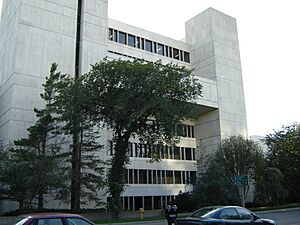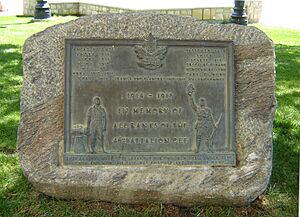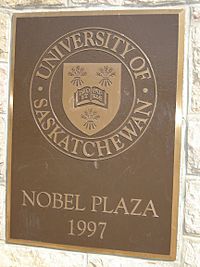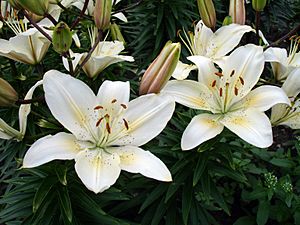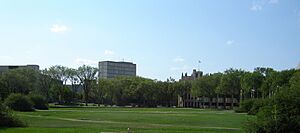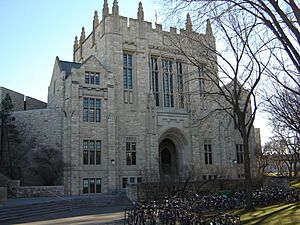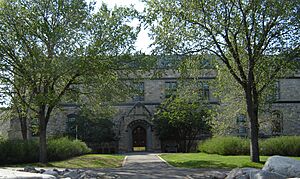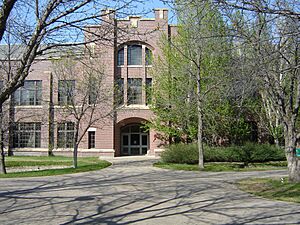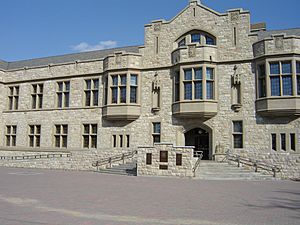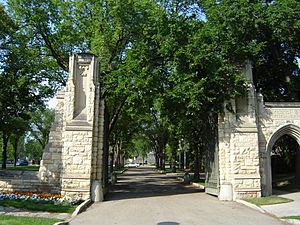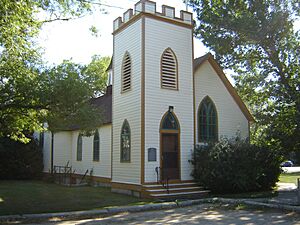University of Saskatchewan facts for kids
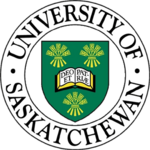 |
|
|
Other name
|
USask |
|---|---|
| Motto | Deo et Patriæ (Latin) |
|
Motto in English
|
For God and Country |
| Type | Public |
| Established | 1907 |
|
Academic affiliations
|
ACU, CARL, UArctic, UASR, Universities Canada |
| Endowment | CAN$509.1 million [1] |
| Chancellor | Scott Banda |
| President | Peter Stoicheff |
| Students | 26,694 |
| Undergraduates | 21,220 |
| Postgraduates | 4,630 |
| Location |
,
Canada
|
| Campus | Urban |
| Colours | Green and yellow and white |
| Nickname | Huskies |
|
Sporting affiliations
|
U Sports, CWUAA |
| Mascot | Howler (the Huskie) |
The University of Saskatchewan (often called USask) is a large public research university in Canada. It was founded on March 19, 1907. The main campus is in the city of Saskatoon, Saskatchewan, next to the South Saskatchewan River.
The university was created to provide higher education for everyone, no matter their background. Today, it is the biggest university in Saskatchewan. It is also a member of the U15 Group of Canadian Research Universities, which is a group of Canada's top 15 universities for research.
USask started as an agricultural college. It was one of the first universities in Canada to have a department that worked directly with the public. The university has a large campus with plenty of space for buildings, farms, and research fields.
The university is known for important scientific work. It is home to the Canadian Light Source synchrotron, a huge and powerful research tool. Scientists at USask also helped invent sulphate-resistant cement and the cobalt-60 cancer therapy machine. The university offers more than 200 different programs for students to study.
Contents
History of the University
How It All Started
The University of Saskatchewan was designed to be like American state universities. It focused on research that would help the people of Saskatchewan, many of whom were farmers. The government of Saskatchewan passed the University Act in 1907, which officially created the university.
The university was set up with two main governing groups. A senate was in charge of academic topics, like classes and degrees. A board of governors handled the university's money and business. The president's job was to connect these two groups.
Several cities, including Regina and Saskatoon, wanted to be the home of the new university. On April 7, 1909, Saskatoon was chosen. The first building opened for students in 1912, and the first degrees were awarded that same year.
The university has always remembered its students and staff who served in wars. The Memorial Gates were built in 1927 to honour those who served in World War I. The names of 67 people from the university who died in the war are written on a stone wall.
Building the Campus
The campus was built next to the South Saskatchewan River, across from downtown Saskatoon. The first buildings were designed in a style called Collegiate Gothic. Canada's Prime Minister, Sir Wilfrid Laurier, laid the cornerstone for the first building, the College Building, in 1910. This building is now a National Historic Site of Canada.
The first buildings were made from a local grey-coloured limestone. This "greystone" became a famous feature of the campus. When the local stone ran out, the university started using Tyndall stone from Manitoba.
The original plan for the campus was to have the buildings arranged around a large green space called The Bowl. This area is still a central part of the campus today. Many of the older buildings are now connected by indoor walkways and tunnels.
Creating the Colleges
Over the years, the university grew and added many different colleges. Each college focuses on a specific area of study. Some of the first colleges were:
- Arts & Science (1909)
- Agriculture and Bioresources (1912)
- Engineering (1912)
- Law (1913)
- Pharmacy & Nutrition (1914)
- Medicine (1926)
- Education (1927)
Later, more colleges were added, including Veterinary Medicine, Dentistry, and Kinesiology (the study of human movement). The university also has several colleges for religious studies that are connected to it.
In 1934, Regina College became part of the university. In 1974, it became a separate university, now known as the University of Regina.
Academics and Research
University Rankings
The University of Saskatchewan is often listed in rankings of top universities. In 2024 and 2025, world rankings placed it among the top 500 universities globally. In Canada, it usually ranks between 14th and 18th. Maclean's magazine ranked it 15th in its Medical-Doctoral category in 2024.
Important Research
The university has a long history of important scientific discoveries.
- In 1948, it built the first betatron (a type of particle accelerator) in Canada.
- In 1951, the world's first non-commercial cobalt-60 therapy unit for treating cancer was built here.
- In 1964, a linear accelerator was built, making the university a leader in nuclear physics.
Today, the university is home to the Canadian Light Source, Canada's national centre for synchrotron research. A synchrotron is a huge machine that helps scientists study materials at a very small scale. The university also has the Vaccine and Infectious Disease Organization (VIDO), which develops vaccines for humans and animals.
Campus Life
Student Activities
Students at USask have many ways to get involved.
- The Sheaf: This is the student newspaper, which has been published since 1912.
- CJUS: This is the student-run internet radio station.
- Place Riel: This is the student centre, with stores, a food court, and meeting rooms. It is named after Louis Riel, an important figure in Canadian history.
The University of Saskatchewan Students' Union (USSU) represents undergraduate students, while the Graduate Student's Association (GSA) represents graduate students.
Huskies Athletics
The university's sports teams are called the Saskatchewan Huskies. They compete against other Canadian universities in sports like:
- Canadian football
- Basketball
- Ice hockey
- Soccer
- Volleyball
- Cross country running
- Track and field
- Wrestling
The Huskies football team has won the national championship, the Vanier Cup, three times. The track and field team has won 12 national championships, making it the most successful team at the university.
Museums and Galleries
The university has several museums and galleries that are open to the public.
- Diefenbaker Canada Centre: A museum dedicated to John Diefenbaker, Canada's 13th Prime Minister. His grave is also located on campus.
- Museum of Natural Sciences: Features displays on the evolution of life, including a full-size replica of a Tyrannosaurus Rex skeleton.
- Museum of Antiquities: Showcases art and artifacts from ancient civilizations.
- Kenderdine Art Gallery: Features a collection of art, with a focus on Saskatchewan artists.
- Gordon Snelgrove Gallery: A public gallery that shows work from students, faculty, and other artists.
Campus Landmarks
- The Memorial Gates: Built to honour students who died in World War I. The gates have the inscription, "These are they who went forth from this University to the Great War and gave their lives that we might live in freedom."
- Rugby Chapel: This small chapel was originally built in 1883 in Prince Albert and was moved to the campus. It is now a protected heritage building.
- Victoria School House: Built in 1888, this was the first schoolhouse in Saskatoon. It was moved to the campus to preserve it and is now a historic site.
Student Housing
The university offers several places for students to live on campus.
- Voyageur Place: This is a group of four residence halls: Saskatchewan Hall, Qu'Appelle Hall, and Athabasca Hall.
- McEown Park: This is a complex of apartment-style buildings for single students, students with partners, and students with families.
- Graduate House: This is the newest residence, opened in 2013 for graduate students.
Working with Indigenous Peoples
The University of Saskatchewan is committed to working with Indigenous communities. The university has a Vice-Provost of Indigenous Engagement to lead these efforts.
There are many services to support Indigenous students. The Gordon Oakes Red Bear Student Centre is a welcoming place for students to gather and find support. The university also offers academic counsellors, tutors, and Elders on campus.
The Kamskénow program is a science outreach program for kids in Saskatoon. University students visit classrooms to lead fun, hands-on science activities.
Notable People
Over 132,000 people have graduated from the University of Saskatchewan. Many have gone on to do great things.
Famous Alumni
- John Diefenbaker: The 13th Prime Minister of Canada.
- Ray Hnatyshyn: The 24th Governor General of Canada.
- Henry Taube: Won the Nobel Prize in Chemistry in 1983.
- Kim Coates: A famous actor known for roles in many TV shows and movies.
- Brad Wall, Roy Romanow, and Scott Moe: All served as Premier of Saskatchewan.
- Alastair G. W. Cameron: An astrophysicist who studied how the Moon was formed.
- Emmett Matthew Hall: A Supreme Court judge who is known as a "father" of Canada's Medicare system.
Famous Faculty
- Gerhard Herzberg: Won the Nobel Prize in Chemistry in 1970. He came to the university in 1935 to escape Nazi Germany.
- Sylvia Fedoruk: A scientist who was part of the team that developed the cobalt-60 cancer treatment. She was also the university's Chancellor and the Lieutenant-Governor of Saskatchewan.
- J.W. Grant MacEwan: A former professor who later became the Lieutenant-Governor of Alberta.
See also
 In Spanish: Universidad de Saskatchewan para niños
In Spanish: Universidad de Saskatchewan para niños


